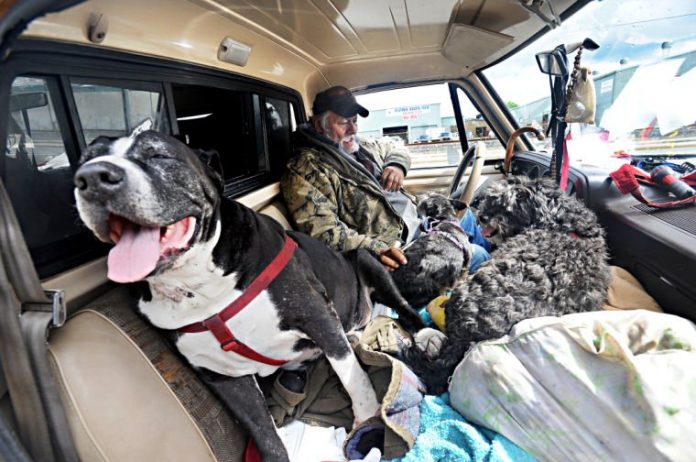
Following a recent court ruling that found the City of Los Angeles’ ban on living in a vehicle unconstitutional, local advocates for the homeless will ask Gilroy officials to stop punishing those who have no other place to sleep.
For Gilroy’s homeless, there is no safe or legal place to spend the night for most of the year. A San Jose-based nonprofit called HomeFirst operates an emergency shelter every winter in the National Guard Armory building in Gilroy.
But the Armory only operates between December and March, and it has a nightly limit of 100 individuals. When that lone shelter is at maximum capacity—or when it’s closed eight months of the year—the area’s homeless people have nowhere else to go, unless they risk costly consequences.
“There is no place they can stay while they’re looking for housing or on a waiting list for transitional housing. People are getting arrested, ticketed and are hiding in the shrubbery for the time being,” Compassion Center Board Chair Jan Bernstein-Chargin said.
It’s a misdemeanor offense to live in a car or truck, and activities like cooking or sleeping in a vehicle are prohibited. It’s also a crime to live in a makeshift encampment on public property. Hiding out on private property constitutes trespassing.
At the July 11 meeting of the Homeless Outreach Task force, comprised of representatives from private and public agencies across Santa Clara County, Bernstein-Chargin proposed asking City Council and the GPD to rethink ticketing homeless individuals for sleeping in their vehicles.
Rather than being charged with living in a vehicle, she said police have been calling it disturbing the peace.
“We’re waking people up to tell them they’re disturbing the peace. Let that sink in,” Bernstein-Chargin said. “They’re not sleeping in the wrong place because they have an option; it’s not their first choice either. They would prefer to live in housing and we could try to help them move in that direction rather than create another barrier.”
In June, the United States Court of Appeals for the Ninth Circuit decided unanimously that Los Angeles’ ban on dwelling in a vehicle is “unconstitutionally vague.”
Gilroy’s law, preventing “human habitation of a motor vehicle,” is just as vague, Bernstein-Chargin said.
As written in the local ordinance, “human habitation” is defined as the use of a motor vehicle for living, cooking or sleeping purposes—or as a dwelling place.
“We all do activities of dwelling—like eating hamburgers—in our cars,” Bernstein-Chargin said. “Let’s say somebody is tired and realizes they’re too tired to drive, so they pull over for a nap. Don’t we want to encourage them to do that rather than continuing to drive?”
When someone violates the vehicle habitation law, the Gilroy Police Department must give the vehicle’s owner a written warning, the ordinance reads. If the vehicle remains after 72 hours, police can impound it. Owners must pay the towing and any associated impound fees, and can be arrested for the misdemeanor offense.
The 9th Circuit Court of Appeals said Los Angeles’ ordinance, which prohibits the use of a motor vehicle as a “living quarters,” doesn’t explain what conduct is actually prohibited. The Los Angeles law also invites discrimination against the homeless and the poor, the court ruled.
“For many homeless persons, their automobile may be their last major possession—the means by which they can look for work and seek social services,” the court’s decision read. “Selectively preventing the homeless and the poor from using their vehicles for activities many other citizens also conduct in their cars should not be one of those options.”
Establishing S. County’s first overnight, year-round shelter
When the newly homeless walk through the doors of the Compassion Center, a Gilroy nonprofit that provides daytime outreach services to the needy, they often ask its staff where the shelter is.
“I’m just as incredulous as they are about the answer. It’s a horrible feeling,” Bernstein-Chargin said, recalling the emotions she feels when she must tell new clients that there is no place to sleep for eight months out of the year. “I warn them that if they try and sleep in their car they can be cited.”
To fill the void, the Compassion Center is raising funds to build an overnight shelter that could accommodate between 40 and 60 individuals and that will be open year-round. Since the campaign kicked off in January, the Compassion Center has raised $165,000 to go towards toward a $200,000 down payment on a future facility, Board Vice-Chair Mike Beasley said.
“We’ve got a place, the people and possibly even have beds. We just need the money,” Beasley added.
Between July and December 2013, 417 homeless people visited the Compassion Center for services, 299 of whom answered a survey about where they sleep at night.
Nearly 16 percent of the respondents—47 individuals—said they were sleeping in a vehicle. Thirty percent of respondents—89 individuals—said they were sleeping outdoors, whether in makeshift encampments or under bridges.
During the six-month period, the oldest homeless person to visit was 90 years old, while the youngest was a newborn baby. A majority of the Center’s clientele has been homeless for more than a year, according to the survey.
Another survey conducted showed there are more than 7,500 homeless individuals across Santa Clara County.
“We need to do more,” Bernstein-Chargin said. “We need to get a shelter open; it makes case management more successful if people are in a fixed location where they can be found and not accumulating more negative consequences from being on the street. We need to designate where the safe and legal places to sleep are, and we need to be advocating for permanent housing—it’s not either or.”













